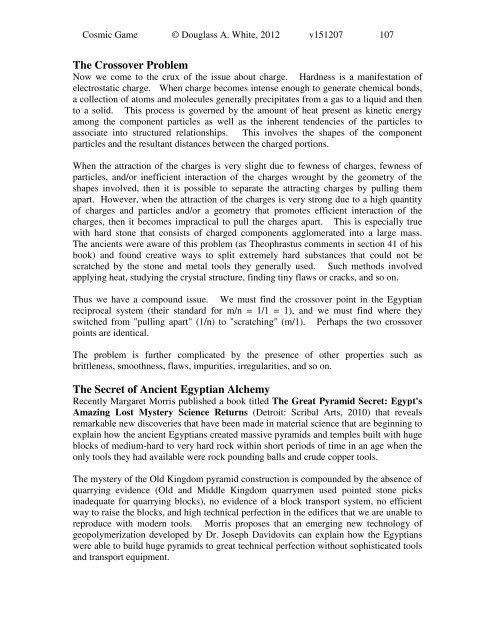Create successful ePaper yourself
Turn your PDF publications into a flip-book with our unique Google optimized e-Paper software.
<strong>Cosmic</strong> <strong>Game</strong> © Douglass A. White, 2012 v151207 107<br />
<strong>The</strong> Crossover Problem<br />
Now we <strong>com</strong>e to the crux of the issue about charge. Hardness is a manifestation of<br />
electrostatic charge. When charge be<strong>com</strong>es intense enough to generate chemical bonds,<br />
a collection of atoms and molecules generally precipitates from a gas to a liquid and then<br />
to a solid. This process is governed by the amount of heat present as kinetic energy<br />
among the <strong>com</strong>ponent particles as well as the inherent tendencies of the particles to<br />
associate into structured relationships. This involves the shapes of the <strong>com</strong>ponent<br />
particles and the resultant distances between the charged portions.<br />
When the attraction of the charges is very slight due to fewness of charges, fewness of<br />
particles, and/or inefficient interaction of the charges wrought by the geometry of the<br />
shapes involved, then it is possible to separate the attracting charges by pulling them<br />
apart. However, when the attraction of the charges is very strong due to a high quantity<br />
of charges and particles and/or a geometry that promotes efficient interaction of the<br />
charges, then it be<strong>com</strong>es impractical to pull the charges apart. This is especially true<br />
with hard stone that consists of charged <strong>com</strong>ponents agglomerated into a large mass.<br />
<strong>The</strong> ancients were aware of this problem (as <strong>The</strong>ophrastus <strong>com</strong>ments in section 41 of his<br />
book) and found creative ways to split extremely hard substances that could not be<br />
scratched by the stone and metal tools they generally used. Such methods involved<br />
applying heat, studying the crystal structure, finding tiny flaws or cracks, and so on.<br />
Thus we have a <strong>com</strong>pound issue. We must find the crossover point in the Egyptian<br />
reciprocal system (their standard for m/n = 1/1 = 1), and we must find where they<br />
switched from "pulling apart" (1/n) to "scratching" (m/1). Perhaps the two crossover<br />
points are identical.<br />
<strong>The</strong> problem is further <strong>com</strong>plicated by the presence of other properties such as<br />
brittleness, smoothness, flaws, impurities, irregularities, and so on.<br />
<strong>The</strong> Secret of Ancient Egyptian Alchemy<br />
Recently Margaret Morris published a book titled <strong>The</strong> Great Pyramid Secret: Egypt's<br />
Amazing Lost Mystery Science Returns (Detroit: Scribal Arts, 2010) that reveals<br />
remarkable new discoveries that have been made in material science that are beginning to<br />
explain how the ancient Egyptians created massive pyramids and temples built with huge<br />
blocks of medium-hard to very hard rock within short periods of time in an age when the<br />
only tools they had available were rock pounding balls and crude copper tools.<br />
<strong>The</strong> mystery of the Old Kingdom pyramid construction is <strong>com</strong>pounded by the absence of<br />
quarrying evidence (Old and Middle Kingdom quarrymen used pointed stone picks<br />
inadequate for quarrying blocks), no evidence of a block transport system, no efficient<br />
way to raise the blocks, and high technical perfection in the edifices that we are unable to<br />
reproduce with modern tools. Morris proposes that an emerging new technology of<br />
geopolymerization developed by Dr. Joseph Davidovits can explain how the Egyptians<br />
were able to build huge pyramids to great technical perfection without sophisticated tools<br />
and transport equipment.





